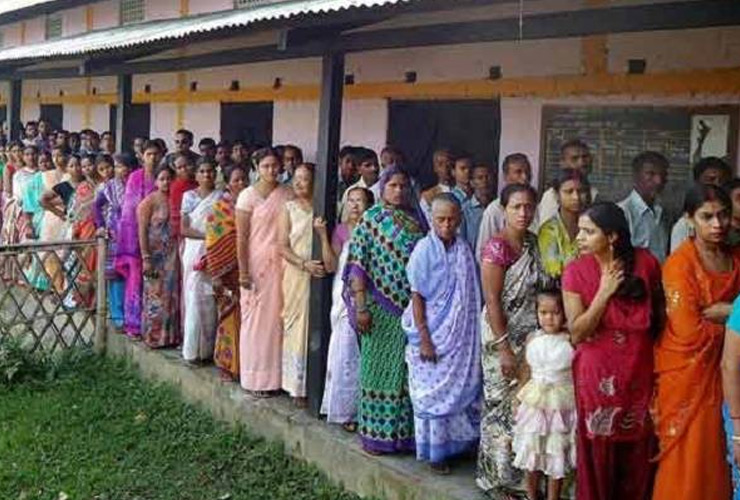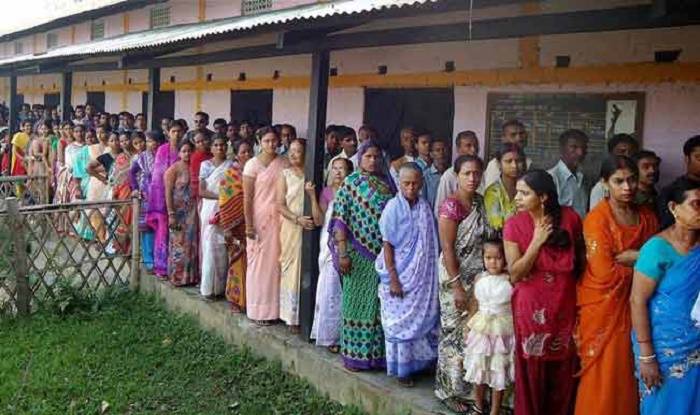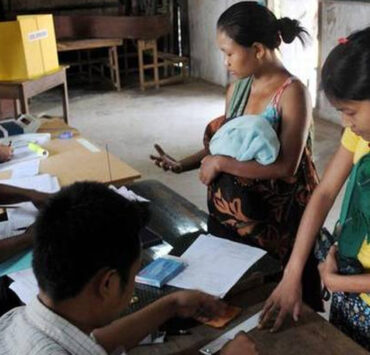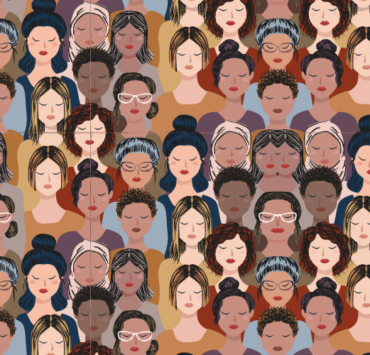
By Rakhi Ghosh

Waiting to vote in the panchayat elections in Odisha.
The Odisha State Assembly recently passed a unanimous resolution seeking 33 per cent reservation for women in state Legislative Assemblies and Parliament. The resolution was passed by a voice vote after a debate in the House. The major Opposition parties – both Congress and Bhartiya Janata Party (BJP) – supported the resolution but later expressed doubts over the motive of the state government in bringing in the resolution ahead of the Assembly election due to be held in Odisha in 2019, concurrent with the general election.
The chief whip of the Congress in the state said the party has no objection if women get 33 per cent reservation in state assemblies and parliament, but added that it felt the move was aimed at influencing women voters.
While initiating the debate on the resolution, Odisha Chief Minister Naveen Patnaik cited the leadership qualities of two tribal women of the state: Mamata Padiami, a young college student from Kalimela in Malkangiri district, and Jayanti Ekka, a grassroots entrepreneur from Sundergarh district.
During a meeting as part of the Ama Gaon Ama Bikash programme at the Secretariat, Mamata Padiami had requested the CM (through a video conference) to increase health insurance for women under the state’s Biju Swasthya Kalyan Yojana (BSKY) from Rs 5 lakh to Rs 7 lakh. The Odisha government, which did not allow the implementation of the central government’s Ayushman Bharat scheme in the state, instead launched the BSKY, a universal health coverage scheme aiming to benefit to around 3.5 crore people from over 70 lakh families in the state.
Jayanti Ekka, who is the president of the federation of self-help groups in Sundergarh district, was invited to share her success story at the recent Make in Odisha conclave in the state capital, Bhubaneswar, in the presence of Naveen Patnaik. Jayanti shared the story of how she had brought together over 15,000 women to produce gram flour, an initiative that has helped to improve the economic status of tribal women of her block, Balishankara, in Sundergarh. Making an appeal to the legislative assembly to extend support to the resolution, Patnaik said, “No household, no society, no state and no country has ever moved forward without empowering its women.”
In early 1992, during the chief ministership of the late Biju Patnaik (father of the present CM, Naveen Patnaik), the then Janata Dal government had for the first time reserved 33 per cent of seats in local bodies for women. Before the 73rd Constitutional Amendment Act came into force in 1993, the Odisha government had already conducted panchayati raj elections (in 1992), with 33 per cent of the seats reserved for women.
Later, in 2011, the Odisha state legislature unanimously gave its nod to the Orissa Panchayat Laws (Amendment) Bill 2011, amending the Orissa Gram Panchayat Act 1964, the Orissa Panchayat Samitee Act 1959 and the Orissa Zilla Parishad Act 1991 to enhance the quota for women from the existing 33 per cent to 50 per cent. This helped thousands of women candidates to contest three-tier panchayat elections as well as municipal elections and get elected.
The resolution which was recently approved unanimously by the members of state assembly has now been sent for central government approval. This resolution could well have an impact on the Women’s Reservation Bill, which has been pending in the Parliament since 1996.
Now that Odisha CM Naveen Patnaik has shown interest in ensuring 33 per cent reservation for women in the state assembly as well, his political party (Biju Janata Dal) should demonstrate commitment to the cause by fielding more women candidates in the forth-coming Assembly election. At present there are only 12 women MLAs in the state Assembly. If the BJD comes to power again in the state – for the fifth time – having enabled more women candidates to contest the assembly election, there will be a good chance that the number of elected women representatives will increase.
The resolution is undoubtedly a first step towards providing political space to female elected representatives across party lines, and changing the hitherto skewed representation in the State Assembly. However, it also leaves many questions to be answered. Real empowerment of women will take place when elected women are given ministerial portfolios that are considered prestigious and powerful, such as finance, revenue and energy. In the past, women politicians have been forced to be satisfied with being ministers looking after Women & Child Development, Handlooms & Handicrafts and other departments viewed as less important. The time has come to not stop at passing a resolution to provide 33 per cent reservation in Assembly seats but also ensure that female political representatives are given powerful positions in ministries and other decision-making bodies.
Equally important is the task of creating an enabling environment and increasing acceptance of women’s leadership among men. Another important move would be to ensure women’s presence in various standing committees.
Also, 33 per cent should not be seen as a ceiling; considering that women make up nearly half the population, they should be given a chance to contest an increasing number of seats.
The BJD must also ensure that the party gives tickets to candidates – both men and women – taking into consideration the heterogeneity of the population and the traditional marginalization of certain sections of society (such as Dalits, Adivasis and other socially and economically disadvantaged communities). Women from tribal, Dalit and other vulnerable communities should get equal representation in the legislature and their voices must be respected. Otherwise, there is every chance that women’s political representation will also be reduced to just filling seats rather than truly serving society. It is a fact that many elected women representatives of Panchayati Raj institutions in the state still struggle to stand out due to the dominance of the patriarchal order.




